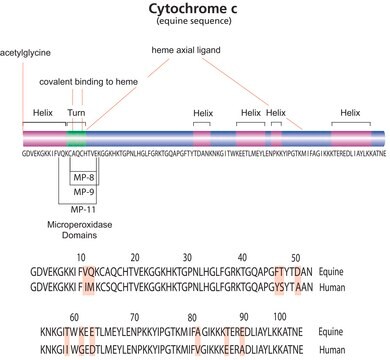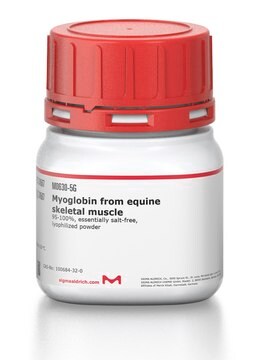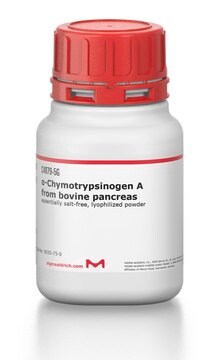C3131
Cytochrome c from bovine heart
≥95% based on Mol. Wt. 12,327 basis, powder, suitable for mammalian cell culture
Synonym(s):
CYC, CytC
About This Item
Recommended Products
biological source
bovine heart
Quality Level
Assay
≥95% based on Mol. Wt. 12,327 basis
form
powder
mol wt
12327 Da
storage condition
(Tightly closed Dry)
technique(s)
cell culture | mammalian: suitable
impurities
0.40-0.50% Iron (anhydrous)
solubility
water: 10 mg/mL, dark red-brown
UniProt accession no.
storage temp.
−20°C
Gene Information
cow ... CYC1(512500)
Looking for similar products? Visit Product Comparison Guide
General description
Cytochrome c (Cyt C) is an essential mitochondrial protein located in the inner membrane of the mitochondria. It is encoded in the nucleus as apo-cytochrome C. Cyt C occurs as membrane-bound or as soluble metalloproteins in energy-transducing membranes and is found in bacteria, archaea, and plastids. It belongs to the group of class IIa cytochromes and contains pentacoordinate heme centres.
Application
- as a component of the assay solution for testing the activity of respiratory chain complexes III and IV in the mitochondria of human osteosarcoma and human hepatocarcinoma cell lines
- to determine the cytochrome c oxidase activity in mitochondria of human aortic endothelial cells
- as a component of the cyt C oxidase reaction solution during in situ enzyme staining of cyt C oxidase in mice kidney tissues
Biochem/physiol Actions
Preparation Note
Other Notes
Application
antibody
related product
Storage Class Code
11 - Combustible Solids
WGK
WGK 3
Flash Point(F)
Not applicable
Flash Point(C)
Not applicable
Personal Protective Equipment
Certificates of Analysis (COA)
Search for Certificates of Analysis (COA) by entering the products Lot/Batch Number. Lot and Batch Numbers can be found on a product’s label following the words ‘Lot’ or ‘Batch’.
Already Own This Product?
Find documentation for the products that you have recently purchased in the Document Library.
Customers Also Viewed
Articles
Separation of Ribonuclease A from bovine pancreas, Type I-A, powder, ≥60% RNase A basis (SDS-PAGE), ≥50 Kunitz units/mg protein; α-Chymotrypsinogen A from bovine pancreas, essentially salt-free, lyophilized powder; Cytochrome c from bovine heart, ≥95% based on Mol. Wt. 12,327 basis; Lysozyme from chicken egg white, lyophilized powder, protein ≥90 %, ≥40,000 units/mg protein
Learn about the four membrane-bound protein complexes that make up the electron transport chain metabolic pathway supplying energy as ATP for cellular respiration.
Separation of Ribonuclease A from bovine pancreas, Type I-A, powder, ≥60% RNase A basis (SDS-PAGE), ≥50 Kunitz units/mg protein; α-Chymotrypsinogen A from bovine pancreas, essentially salt-free, lyophilized powder; Cytochrome c from bovine heart, ≥95% based on Mol. Wt. 12,327 basis; Lysozyme from chicken egg white, lyophilized powder, protein ≥90 %, ≥40,000 units/mg protein
Separation of Ribonuclease A from bovine pancreas, Type I-A, powder, ≥60% RNase A basis (SDS-PAGE), ≥50 Kunitz units/mg protein; α-Chymotrypsinogen A from bovine pancreas, essentially salt-free, lyophilized powder; Cytochrome c from bovine heart, ≥95% based on Mol. Wt. 12,327 basis; Lysozyme from chicken egg white, lyophilized powder, protein ≥90 %, ≥40,000 units/mg protein
Protocols
Enzymatic Assay of Ferredoxin NADP Reductase (EC 1.18.12)
Chromatograms
application for HPLCapplication for HPLCapplication for HPLCOur team of scientists has experience in all areas of research including Life Science, Material Science, Chemical Synthesis, Chromatography, Analytical and many others.
Contact Technical Service




